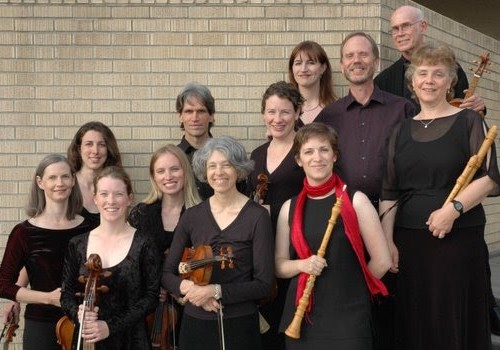On tonight's show:
Baroque Chamber Orchestra of Colorado
Charley talks with Baroque Chamber Orchestra co-leader Frank Nowell about their concerts this weekend. We'll also hear a 2006 all-Bach program, excerpts from their “Echoes of Venice” concert, and recordings made by their co-leaders in our Performance Studio. Listen to extended interview (web extra).
Johann Sebastian Bach: Suite in A minor, BWV 1067 Bach_Suite_No_2">notes
Johann Sebastian Bach: Two-Violin Concerto in D minor, BWV 1043
Baroque Chamber Orchestra of Colorado
Debra Nagy, oboe
Cynthia Miller Freivogel, violin
Tekla Cunningham, violin
recorded 9/23/06
Biagio Marini: Echo Sonata
Baroque Chamber Orchestra of Colorado
Tekla Cunningham, Kathleen Leidig, Stacey Brady, violins
recorded 9/26/09
Georg Philipp Telemann: Violin Sonata No. 2 in D major
I. Allemande
II. Corrente
III. Sarabande
IV. Gigue (web extra)
Frank Nowell, harpsichord
KVOD Performance Studio: recorded 7/14/06
Produced by Martin Skavish
Program Notes
Johann Sebastian Bach (1685-1750): Suite No. 2 in B minor, BWV 1067
I. Ouverture
II. Rondeau
III. Sarabande
IV. Bourrée
V. Polonaise: Lentement
VI. Menuet
VII. Badinerie
After working for Prince Leopold of Anhalt-Cöthen, Bach was appointed cantor of the St. Thomas School in Leipzig. He moved family and furniture in May of 1723. His job description included duties as civic director of music, and this meant numerous odious encounters with the Town Council. He complained of “superiors who are strange people, with little regard for music.”
Some relief from his official duties came in 1729, when he was asked to direct the Leipzig Collegium Musicum, a group founded 25 years earlier by Telemann. During the winter, they performed from eight to ten o'clock every Friday night at Gottfried Zimmermann's coffeehouse. In the warmer months, they moved outdoors in the garden for concerts from four to six o'clock on Wednesday afternoons.
All four of the Suites for Orchestra were played at these concerts, although three of them may have been written earlier, at Cöthen. Martin Bernstein believes the Second Suite was written in the early 1730s for Pierre-Gabriel Buffardin, first flutist in the Dresden Orchestra. Buffardin had given lessons to Bach's older brother Johann Jacob--in Constantinople, of all places.
Teri Noel Towe writes: “This elegant and glittering suite must have done much to enhance Bach's already great reputation when Buffardin played it with the Dresden court orchestra. Brilliant musician that he was, Buffardin certainly must have appreciated such subtle touches as the remarkable canon…in the Sarabande and the construction of the Double of the Polonaise over a bass line that is an exact quotation of the theme of the Polonaise proper.” The final movement, titled “Badinerie,” is a witty and dance-like substitute for the traditional dance movements of the suite.
Johann Sebastian Bach (1685-1750): Double Concerto in D minor, BWV 1043
I. Vivace
II. Largo ma non tanto
III. Allegro
In 1717 Bach assumed his new position as court conductor to Prince Leopold of Anhalt-Cöthen. “My gracious prince loved and understood music,” he later recalled. Much of Bach's secular, instrumental music dates from his tenure at Cöthen, including a series of violin concertos.
The Double Concerto was written about 1720. “The attack of the first movement is uncompromising,” says Geoffrey Crankshaw, “and the contrapuntal exchanges of the orchestra are matched by those of the two soloists, using a variant of the main theme. The self-consistent logic of this movement is contrasted with the exalted calm of the second movement, whose serene canon, unfolded…by the soloists against a softly beating accompaniment, takes us beyond earthly experience. In the third movement, energy returns in an argument dominated by the soloists. Bach's use of double-stopping in both solo parts is a marvelous stroke of poetic intensity.”
The score calls for two solo violins, strings and continuo.
©2010 Charley Samson
